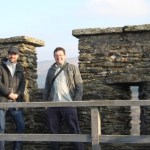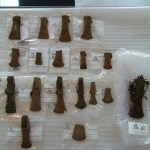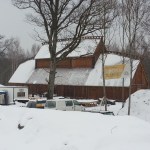

Aardvarchaeology
Dr. Martin Rundkvist is a Swedish archaeologist, journal editor, public speaker, chairman of the Swedish Skeptics Society, atheist, lefty liberal, board gamer, bookworm, and father of two.
I found something pretty wild in an essay by J.L. Borges this morning. There's a 13th century Norse saga about the Buddha. And the story has other fine twists as well. This all revolves around a legendary tale of the Buddha's early life.
In the 6th century BC a son was born to a petty king in what is now Nepal. He was named Siddharta, and it was prophesied shortly after the boy's birth that he would become either a great king or a great holy man. His father then kept him carefully protected from contact with religion and human suffering, apparently to keep the boy away from the holy-man…
The Swedish Church lost 54,000 members last year. That's more than half a percent of the country's population.
Yay! Eight years after submission, a star-crossed paper of mine has finally appeared in print! I was at this provincial museum in 2004, looking at finds, and the staff asked me for a paper to put in their annual. Then they discontinued that annual and told me to send my paper to a certain national journal. I did, it got accepted, and then that journal stalled for several years. The volume I'm in is for 2009 and appeared in late 2012.
Wikipedia and my smart phone turn everything I…
I used to be kind of angry and disappointed with Kraftwerk. The only album they put out after I started listening to them was 1986's Electric Café which is OK but not great, and after that, no new material. But now I look at their catalogue and think, hey, from 1974 and for seven years on, they released five amazing albums. The stellar Computer World appeared in 1981, the year when Hütter & Schneider turned 35 and 34. In terms of the normal productivity and creativity arc of a band, Kraftwerk have nothing to be ashamed of. And there is that nagging question of what Ralf Hütter's 1983…
In this well-written, painstakingly annotated and beautifully designed book, physicist Baruch Sterman (with contributor Judy Taubes Sterman) traces the history and prehistory of a certain blue pigment, along with its cultural and religious significance through the ages. It's what the Torah and Talmud calls tekhelet, and it's made from a gland harvested from Murex sea snails.
Though greatly interested in history, archaeology and biology, I find myself poorly equipped to engage with the book's subject matter. Or put differently, I don't think I'm part of its intended audience. Because there's a…
Kay Glans used to edit the literary pages of Svenska Dagbladet, Sweden's main conservative* newspaper, and Axess Magasin, a conservative Swedish arts & social sciences mag that also has a TV channel. The latter's standard is high, and I've been particularly pleased to find repeated staunch rebuttals of post-modernism there. What I don't like much in Glans's oeuvre is a tendency for aesthetic idealism and aesthetic conservatism, of the canon-stroking sort. His writers tend to believe that there are classics that every educated person should read. I'm an aesthetic relativist and accept no…
Registration has opened for the 15th European Skeptics Conference. Hie thee there and register NOW, because there's only 400 tickets!
Here's the confirmed (still evolving) line-up:
Anna Bäsén (Sweden): Undercover Health Journalism
Chris French (UK): Psychological Perspectives on Paranormal Belief and Experience
Maria Berglund (Sweden): Våra opålitliga hjärnor: hur fel vi uppfattar världen och hur fel vi tänker om det vi uppfattar
Dénis Caroti (France): CorteX and Chomsky's Wish
Kendrick Frazier (US) of the Committe for Skeptical Inquiry: title to be announced.
Christer Fuglesang (Sweden):…
After only one day of my teaching, one of my Kalmar students has already twigged that there's a funny discrepancy between the course's post-modernist meta-archaeological syllabus and the opinions voiced by his main teacher from the lectern and elsewhere. Fearlessly he goes for my jugular on the course blog, where all the students have to post in order to pass the course, and I respond.
The Grey Mouser, along with Fafhrd the Northerner hero of Fritz Leiber's genre-defining sword & sorcery story cycle, is the archetype of the Dungeons & Dragons thief. He began his career however, Leiber informs us, as apprentice to a "hedge-wizard" who taught him some simple magical cantrips. I never understood what a hedge-wizard was, until now. I imagined it had to do with living in a squalid cottage out in the fields and being in touch with nature, druid-like.
Reading Avram Davidson's story "The King Across the Mountains", I now came across a hedge-parson. And googling, I found out…
Juniorette's best buddy Betty looks a lot like Juniorette and is almost like a second daughter to me. Her mom is Korean and her dad is Turkmen, great people both. The other day Betty got into a fight at school with another girl who started calling her names. (Betty, by the way, is a very well put together child and not overweight at all.)
Other Girl: You fat Chinese!
Betty: You can be a fat Chinese!
Other Girl: But I'm not Chinese!?
Betty: Me neither!
Some Facebook updates.
Bolsängen: an Uppland smallhold whose name (thanks to the Swedish method of making compund nouns) means "the sexual intercourse bed".
The Poupon mustard brand got its name from the firm's coprophiliac founder, who liked to encourage his staff with a friendly "Poop on, guys! Poop on!"
I'm helping Adele Adkins with some revision of her lyrics. Her scansion is OK but the rhymes need some touching up. Here's a sample of what I'm coming up with.
Don't forget me I beg
I remember, you smeg
Sometimes it lasts in love
But sometimes it hurts my leg
Three great Swedish words:…
Sweden used to have its own version of Irish Coffee: kaffekask. It was big in the 19th century and I believe it dropped from favour during our 1917-55 period of liquor rationing. Nobody seems to drink kaffekask anymore.
A kask is a type of helmet like the ones worn by English bobbies. But that's apparently not the etymology of kaffekask. More likely it comes from Low German karsch, "harsh", "abrasive".
Kaffekask consists only of coffee and 40% (70° proof) potato schnapps plus optionally a sugar cube per cup. Swedish schnapps (brännvin, "burn wine") is usually flavoured and does not to my…
In my career (such as it is), I keep running into a hurdle having to do with the great value placed in the arts/humanities on the novelty of interpretations. Time and again, reviewers will say that my work tackles interesting questions in a methodologically competent manner using solid data – but that my interpretations (humanities people aren't comfortable with calling them “results”) aren't novel enough.
This makes no sense to me. I don't aim to produce a new interpretation. Nor do I wish to retain an old one. I just want to find the most-likely-to-be-correct answer to the question, given…
Here's a guest entry from my friend Professor Howard Williams of the University of Chester. He was my charming guide on an antiquarian road trip Sunday.
I met Martin at his luxurious guest accommodation on the main campus of the University of Chester and we got into my trusty VW. We left Chester, heading around the historic city and out on the Wrexham Road over the 18th-century Grosvenor Bridge over the River Dee and into Wales. Driving along the A55 along the spine of Flintshire, we stopped near Whitford to investigate two sites.
First, we visited the 3.4m-high early medieval cross-slab at…
My Linnaeus University colleague and trätobroder (debate adversary) of many years, Cornelius Holtorf, published a book in 2007 under the title Archaeology is a Brand. That is certainly a possible way of looking at it. But preparing a talk on internet archaeology, I made a little discovery. Look at what this brand appears to be worth! There is hardly any demand for the words ”archaeology” or ”archeology” as internet domain names.
archaeology.com
undeveloped
archeology.com
undeveloped
archaeology.org
US paper mag
archeology.org
undeveloped
archaeology.net
small NYC web design firm…
My paper on the re-use of Late Iron Age picture stones during that same period (mainly in late male graves) has been published in English and Swedish parallel versions of Gotländskt Arkiv 2012. That's the annual of the Gotland County Museum. Have a look! Questions and comments are most welcome.
Current Archaeology #276 (March) has a feature on excavations for a new container port that's being built at Stanford Wharf near the mouth of the Thames. The Iron Age and Roman Period archaeology proved quite lovely, with waterlogged salt-making sites, remains of a boat house, loads of pottery, even waste from garum fish-sauce making. But the reason for the excavation is also interesting.
Consider the terms “nature reserve” and “nature preserve”. Most of us probably think of them as bits of particularly fine nature that are fenced in and preserved. But at Stanford Wharf much of the…
The Midgardsenteret visitors' centre at Borre invited me to give a talk about my Östergötland elite settlement project. This went well, with a sizeable and appreciative audience last night. One gentleman explained that they had all learned Swedish from watching kids' TV when they were little. Today I went on a royal Late Iron Age binge.
This is Vestfold, home of the Norwegian branch of the Ynglingar dynasty, with sites like Oseberg, Gokstad, Kaupang, Huseby, Gulli – and Borre. The ancient cemetery starts right outside the main entrance to Midgardsenteret with some low mounds of respectable…
Karl Olausson has just submitted his Bachelor's thesis in history: a study of the post-WW2 Swedish boardgame market. The material he's used is largely interviews with people in our country's boardgame business. Karl has kindly given me permission to put the work on-line (in Swedish). Here's the abstract:
This essay is about the history of the Swedish board game-industry from the 1970’s to today. The essay focuses on the companies in the business and how they change during this period and about the causes of this change. This essay aims both at accurately describing the development of the…
It’s time we had a de-lurk around this here blog! The last one was over a year ago. If you keep returning to this blog but rarely or never comment, you are a lurker, Dear Reader, and a most welcome one too.
Please comment on this entry and tell us something about yourself – like where you are, what your biggest passion is, what you’d like to see more of on the blog. And if you are a long-time lurker who has de-lurked before, re-de-lurks are much encouraged!
I'm happy to note that Aard's traffic is now back at its pre-Wordpress level: 880 daily uniques in January. I believe this is due to three factors: more frequent entries, a small traffic peak thanks to the Hårby valkyrie, and above all my return to tagging.
I don't know why I quit tagging. Just lazy I guess. Tags are the little clickable keywords you've been seeing at the bottom of entries lately. Google places great stock on them. If I understand correctly, the search engine will place a tagged blog entry much higher in the search results than an identical entry without the tags. Tags…







